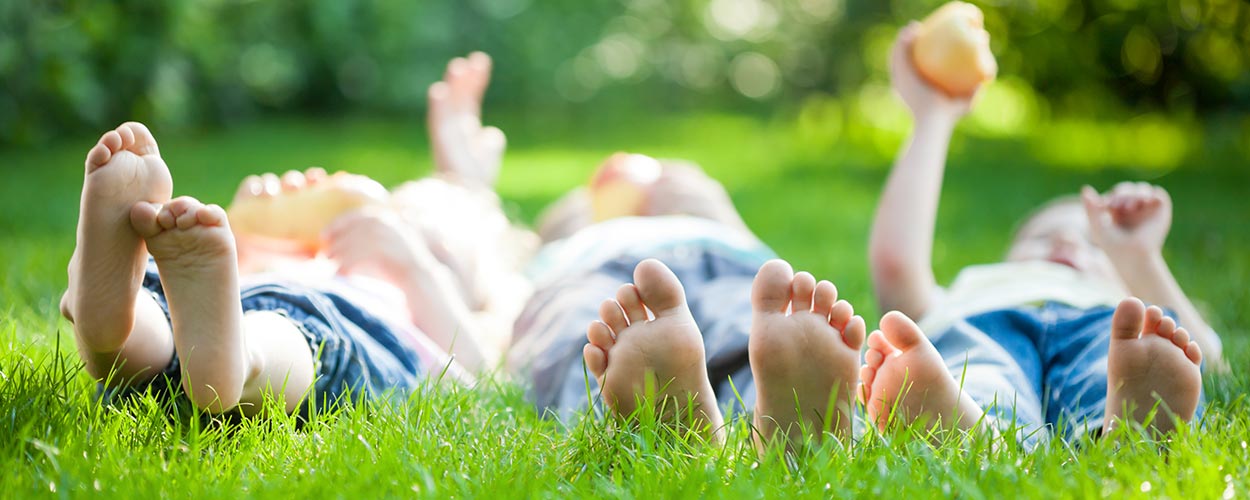- Bariatric Surgery
- Cardiology
- Transplants
- Neurology
- Oncology
- Bladder Cancer Treatment
- Bone Cancer Treatment
- Breast Cancer Treatment
- Colon Cancer Treatment
- Esophagus Cancer Treatment
- Kidney Cancer Treatment
- Leukemia Treatment
- Liver Cancer Treatment
- Lymphoma Treatment
- Lung Cancer Treatment
- Myeloma Treatment
- Prostate Cancer Treatment
- Pancreatic Cancer Treatment
- Ovarian Cancer Treatment
- Testicular Cancer Treatment
- Orthopedics
Run Free, Run Barefoot!
General Health, Orthopedics
Does anyone remember the time as a child when running barefoot across the lawn, shrieking with joy and playing around was a big source of happiness? Spending hefty amounts on best of the running shoes, we have completely forgotten what it is like to run or just walk barefoot. However, with the growing awareness and upcoming trend of running barefoot in the past few years, more and more people are taking an interest in shunning their sports shoes for a good run.

But the question is: is it worth the hype that is created around it? This trend is picking up even more pace after Christopher McDougall’s epic book Born to Run in 2009 which has impacted a lot of people in the running community. It is claimed that running barefoot strengthens the feet, decrease the risk of stress injuries, and improve the overall performance of the runner. Nike Performance Council Member Lance Walker says that there is a change in the activation pattern of the barefoot runner which is related to strengthening and improvement of hip and lower limb muscles along with better motion of ankle. Going further ahead he even said that there is significant improvement in running efficiency and endurance in case of running without shoes on. Sports Medicine specialists are also highlighting the benefits of running without shoes as it reduces sports injuries like stress fractures and also the impact on knees.
Studies published in renowned journals like Nature suggest that there is difference in footfall of a barefoot runner and a shod runner. The science behind it shows that the human foot is designed in a way that during the fall it is pushed in a forward motion with a spring like motion of the foot’s natural arch, leading to minimal or no impact collision in comparison to heel-strike motion of shoe runner.
History tells us that running barefoot that our ancestors walked and ran barefoot in search of basic amenities and it was a very common practice. Over time, they started wearing kind of shoes made from woven sage-bush and moccasins. It is believed that runners in ancient Greece ran long distances barefoot and the legend of Pheidippides claims that he ran from Athens to Sparta in no more than 36 hours in order to inform Athenians of their victory over Persia. In more recent times, the famous Abebe Bikila of Ethiopia won the Rome Olympic marathon, 1996, by running barefoot as he didn’t have running shoes in his size. Another Olympian, Zola Budd from South Africa ran without shoes in 1980 Olympics Games and also won the IAAF World Cross Country Championships in 1985 and 1986. There are several other prominent runners who choose to run long distance marathons and competitions with no shoes on their feet and they have performed well in doing so.
Even today, barefoot running is a regular practice amongst Kenyans and Tarahumara Indians. This practice is also gaining lot of fame in the rest of the world. The Barefoot Runner Society in the US was founded in 2009 and has more than 1500 members today. Many marathon and cross country runners have come up with their success stories of running without shoes. There are several names with track records and titles like Teage O’Connor who broke the record for 100 km run with an aim to raise funds his environmental education center known as Crow’s Path. Ken Bob Saxton is popularly known as the “godfather of barefoot running”, and Todd Byers from Seattle who ran over 100 marathons barefoot are some other shining names in the list of achievers.
Connect with Experts & Get a Free Personalized Quote
Despite all these facts, the debate for barefoot vs. shod runners is still an ongoing topic and there aren’t many reports in its support. It is still not certain that the increase in strength and integrity of foot’s natural arch in barefoot running will impact on the sports performance or injury-reduction. The only true evidence that research support is that running barefoot improves metabolic efficiency, more than in the case of running with shoes on. Another problem which a common runner or an interested one will face is that years of practice of using shoes had made our foot soft and weak because cushioning and padding to the feet. So starting immediately with barefoot running creates musculoskeletal injury like pain in the ankles and forefoot and even blisters. So a person should ease into the practice of running barefoot by first beginning with slow and short running without shoes. Also, sets of strengthening exercises for foot, ankle, hips and lower limb muscles can help build up our core strength which will reduce the risk of related injuries.
As the bottom line, many sports persons have explained barefoot running to be joyous and exhilarating experience. It can give you a sense of liberation and freedom which enhances our overall health and mental peace.

Written By Dr. Suneet Singh
Cost Calculator

Top Specialities
- Best Doctors in India
- Best Bariatric Surgeons in India
- Best Bone Marrow Transplant Doctor in India
- Best Cardiologist in India
- Best ENT Doctor in India
- Best Epilepsy Doctors in India
- Best Gastroenterologist in India
- Best Hair Transplant Surgeon in India
- Best Hematologist in India
- Best Hip Replacement Surgeon in India
- Best Infertility Doctor in India
- Best Knee Replacement Surgeon in India
- Best Liver Transplant Surgeon in India
- Best Nephrologist in India
- Best Neurologist in India
- Best Neurosurgeon in India
- Best Oncologist in India
- Best Orthopedic Doctor in india
- Best Ophthalmologist in India
- Best Penile Implant Surgeon in India
- Best Penile Enlargement Doctor in India
- Best Plastic Surgeon in India
- Best Pulmonologist in India
- Best Rhinoplasty Surgeon in India
- Best Rhinoplasty Surgeon in Turkey
- Best Spine Surgeon in India
- Best Urologist in India
- Best Cardiologists in the World
Top Treatments
- Bone Marrow Transplant Cost in Turkey
- Gastric Band Cost Turkey
- Cochlear Implant Surgery Cost in India
- Cancer Treatment Cost in India
- Erectile Dysfunction Treatment Cost in India
- Hair Transplant Cost in India
- Laser Eye Surgery Cost in India
- Penile Implant Surgery Cost in India
- Penis Enlargement Surgery Cost in India
- Spine Surgery Cost In India
- 5000 Grafts Hair Transplant Cost Turkey
- Gastric Sleeve Surgery in Turkey
- Turkey Hair Transplant Package
- Liver Transplant in Turkey
- Penis Enlargement in Turkey
- Kidney Transplant Cost in Turkey
- Knee Replacement in Turkey
- IVF Cost in Turkey
- Proton Beam Therapy Cost in India
- LVAD Cost in India
- Pediatric Liver Transplant Cost in India
- Limb Lengthening Surgery Cost in Turkey
- 5000 Grafts Hair Transplant Cost Turkey
- 5000 Grafts Hair Transplant Cost
- Liver Transplant Success Rate in India
- Liver Cancer Treatment Cost
- Pancreatic Cancer Treatment Cost
- Prostate Cancer Treatment Cost
Best Hospitals for Top Treatments
- Best Blood Cancer Hospital in India
- Best Bone Cancer Hospital in India
- Best Bone Marrow Transplant Hospitals in India
- Best Breast Cancer Hospital in India
- Best Cancer Hospitals in India
- Best Hospital for Brain Tumor in India
- Best Hip Replacement Hospital in India
- Best Heart Hospital in India
- Best Kidney Transplant Hospital in India
- Best Knee Replacement Hospital in India
- Best Liver Cancer Hospital in India
- Best Liver Transplant Hospital in India
- Best Lung Cancer Hospital in India
- Best Neurology Hospital in India
- Best Orthopedic Hospital in India
- Best Spine Hospitals in India
- Best IVF Centre in India
- Best IVF Clinics in Turkey
- Best Hair Transplant Clinic in Turkey
- Best Prostate Cancer Hospital in India
- Best Hospital for Cyberknife Treatment in India
- Best Urology Hospital in India
- Best Hospitals for Pancreatic Cancer Treatment in India
- Best ENT Hospital in India
- Best Kidney Transplant Hospitals in Turkey
- Best Hematology Hospital in India
- Best Lymphoma Treatment Hospitals in India
Latest Articles
- Best Countries for Plastic Surgery
- Best Countries for IVF
- Best Countries for Hair Transplant
- Blood Cancer Treatment Cost
- Brain Tumor Surgery Cost
- Robotic Heart Surgery Cost
- Knee Replacement Surgery Cost
- Penis Enlargement Surgery Cost
- Penile Implant Surgery Cost
- Liver Transplant Cost
- Gastric Band Abroad
- Tummy Tuck Abroad
- Gamma Knife Surgery Cost
- Spinal Fusion Surgery Cost
- Gastric Sleeve Abroad
- Gastric Bypass Abroad
- Scoliosis Surgery Cost
- Heart Valve Replacement Surgery Cost
- Life Expectancy After Kidney Transplant
- Best Country for Rhinoplasty
- Bone Marrow Transplant Success Rate
- Bone Marrow Transplant Cost
- Best Countries for Breast Augmentation
- Heart Bypass Surgery Cost
- Best Country for Cancer Treatment
- Hip Replacement Surgery Cost
- Kidney Transplant Cost
- Breast Cancer Treatment Cost
Disclaimer: Lyfboat does not provide professional medical opinion on the treatment or diagnosis of a particular ailment. All the offered services and information presented on www.lyfboat.com are only for the purpose of public knowledge and cannot substitute the professional consultation of the physician. Lyfboat strongly advice against copying or cloning of its web content and follows the legal protocols for protection of its intellectual property.
© 2024 Lyfboat Technologies Pvt. Ltd. All Rights Reserved.
Please wait